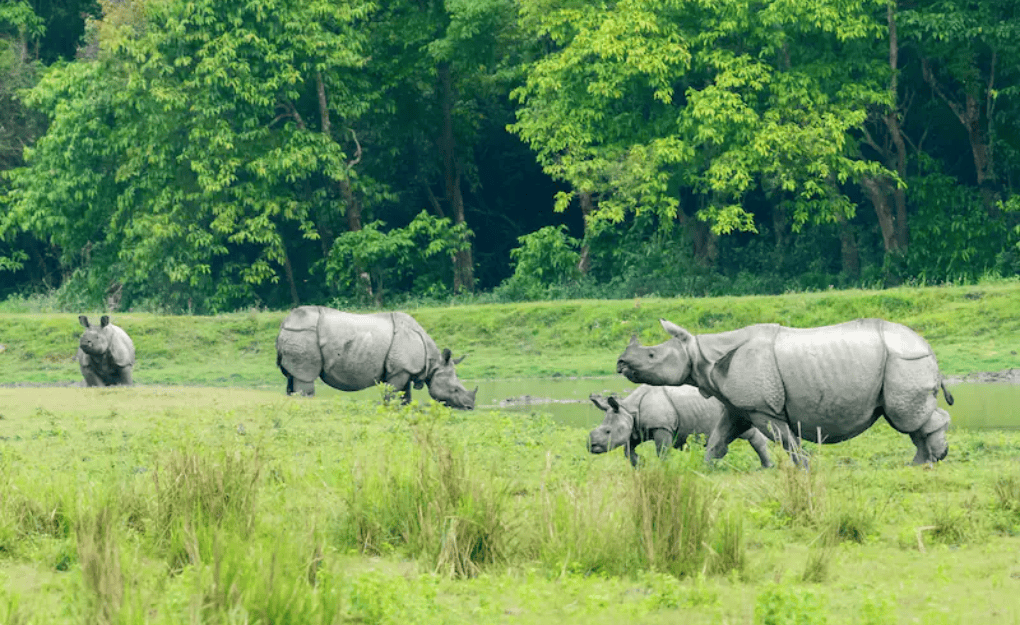The Genetic Analysis of Rhino in Assam has taken a major leap forward, as the state’s forest department, in collaboration with the Wildlife Institute of India (WII), has begun detailed DNA profiling of rhino horn samples. These efforts are part of the RhoDIS India programme, aiming to build a comprehensive genetic database that supports both conservation and criminal investigations involving rhino poaching.
Background of Rhino Horn Destruction
In a historic conservation move in September 2021, the Assam government destroyed 2,479 rhino horns—the largest such destruction event globally. The goal was to send a strong message against illegal rhino horn trade and poaching. The destruction took place publicly and symbolically to promote transparency and raise awareness about wildlife crime.
However, before the horns were incinerated, scientific foresight led authorities to collect small samples from many of them. These samples have now become the foundation of the state’s genetic research initiative, supporting ongoing efforts to track and monitor the state’s rhino population through modern science.
Sample Verification and Secure Transfer
From July 3 to July 8, 2025, a specialised team from the Assam Forest Department conducted a careful verification and segregation process at Kaziranga National Park, the stronghold of India’s one-horned rhinoceros. Out of the collected materials, 2,573 horn samples were deemed fit for genetic study.
Each sample was meticulously repackaged in sterilized vials using strict protocols to prevent contamination. The entire repackaging process was monitored by a panel of independent experts, NGO observers, and wildlife biologists to ensure transparency, scientific accuracy, and accountability.
Role of Wildlife Institute of India and RhoDIS Programme
These verified samples were sent to the Wildlife Institute of India (WII) in Dehradun, where they are being processed under the RhoDIS (Rhino DNA Index System) India programme. Launched in 2016, RhoDIS India is modeled after a successful South African system. It is led by the Ministry of Environment, Forest and Climate Change, WII, WWF-India, and participating rhino-bearing states like Assam.
The Genetic Analysis of Rhino in Assam will result in a national-level DNA registry of rhinos, much like a fingerprint database. This genetic index helps law enforcement agencies identify the origin of confiscated rhino horns and aids in solving wildlife crime cases.
Scientific Objectives and Methodology
The primary goal of this genetic research is to analyse Short Tandem Repeat (STR) markers, which are highly variable segments of DNA. These markers provide insights into the genetic diversity, inbreeding levels, and breeding potential of rhino populations in Assam.
By comparing current data with past genetic trends, scientists aim to detect any loss of diversity or changes in population structure. Such information is vital to ensuring that rhinos continue to breed healthily and remain resilient against diseases and environmental stressors.
Collaboration and Oversight
This project is not operating in isolation. It is a joint effort involving WII, the Assam Forest Department, WWF-India, and international experts. The oversight committee includes government officials, NGOs, academics, and independent wildlife professionals. Their task is to supervise sampling, transport, analysis, and eventual integration of results into conservation planning.
This kind of multi-stakeholder collaboration adds credibility and global recognition to Assam’s rhino conservation model. It also sets a precedent for other Indian states and international wildlife protection efforts.
Legal and Forensic Implications
Apart from conservation, the Genetic Analysis of Rhino in Assam has vital forensic applications. Rhino horns are highly valuable in illegal wildlife markets. DNA profiling can determine whether a seized horn comes from a protected area in Assam or elsewhere. This supports legal prosecution by offering scientific evidence in court, reducing the reliance on circumstantial proof.
The RhoDIS database can also link horns to individual rhinos, providing a lineage map that tracks genetic connectivity between populations and their geographic spread.
Conservation Significance
Assam holds the majority of India’s one-horned rhinoceros (Rhinoceros unicornis) population, primarily in Kaziranga, Pobitora, and Manas National Parks. Protecting these animals is crucial not just for biodiversity but also for tourism and the regional economy.
By embracing scientific tools like DNA analysis, Assam is taking rhino conservation to the next level. These efforts help identify vulnerabilities in the population, track movement patterns, and combat illegal wildlife trade.
Conclusion
The Genetic Analysis of Rhino in Assam represents a forward-thinking approach in conservation science. It combines traditional fieldwork with advanced molecular techniques to protect one of India’s most iconic species. Through programmes like RhoDIS India, Assam is building a stronger, data-driven future for rhino protection—benefiting not only wildlife but also environmental justice and sustainable biodiversity management.




